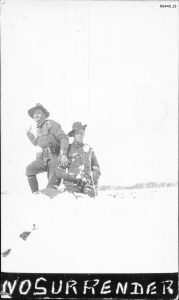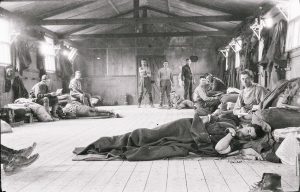Twentieth century warfare was fueled by steel, gunpowder and ready food supplies.
We can add wool to that list, according to Griffith Film School Professor Trish FitzSimons and visiting Fulbright Senior Scholar Madelyn Shaw.
The pair are working on a new creative research project, The Fabric of War, that explores how the global wool trade enabled mass warfare, from the trenches of WWI to the conflict in Korea.
The project was inspired by Professor FitzSimon’s discovery of a trove of letters fromher grandfather – a wool buyer who travelled between Australia, the US and UK in the early 1900s.
“By chance, I was in the US soon after reading the letters, and I came across an exhibition Madelyn had curated at the New York City Museum, Homefront and Battlefield – Quilts in Context in the Civil War,”she said.
“I started to knit the pieces together – wool, war and politics.
“I love that you can start with a tiny story, a little scrap of fabric, and weave it into a huge canvas.”
Professor FitzSimons is a 2019 Queensland Smithsonian Fellow. She has spent time in the US this year completing research and developing the transnational project with Ms Shaw, a curator at the National Museum of American History.
A key aspect of the project is an exploration of the close, often contentious, ties between Australia – the centre of the world’s wool market – and the United States – one of its principal customers.
“This project is a way of unpacking a much bigger story – the whole huge and fascinating story of Australia and US,” said Professor FitzSimons.
“Wool is a global commodity and a vital strategic resource, especially in the 19th and 20th centuries.
“There is a whole complex history of wool, and it’s not all warm and fuzzy.
“As a nation, we rode on the sheep’s back, but we never stopped to ask what happened to the wool after it left our shores.”
Ms Shaw is based at Griffith for the next six months on a Fulbright Scholarship – the prestigious fellowship that counts heads of state and Nobel Prize winners amongst its alumni.
“The program allows the world to come to the US and the US to go to the world,” she said.
“It is also one of the few programs in the US that has bipartisan support, and it opens so many doors.”
 The Fabric of War creative research project involves four short documentaries and a website – with the intention that it form the framework for a travelling exhibition, where local museums and galleries use the films and interactive material to showcase their own material.
The Fabric of War creative research project involves four short documentaries and a website – with the intention that it form the framework for a travelling exhibition, where local museums and galleries use the films and interactive material to showcase their own material.
“Every institution has uniforms, blankets and basic objects related to wool and war,” said Ms Shaw.
“What you need is the context – and we hope our project provides a template for innovative museology.
“A lot of institutions are trying to put on good work, but with budget cuts, fewer staff, it can be an uphill battle.
“A project like this will allow institutions to take this and run with it.”
Professor FitzSimons and Ms Shaw are excited about the possibility of using film to illuminate the complex history of wool and war.
“The films help you look at objects and understand what they mean,” said Professor FitzSimons.
“And the objects displayed in the museum help take the films and make them personal.
The first documentary was generously financed by Griffith Enterprise and Wool Innovation Australia, and the pair are hopeful of securing an ARC Linkage Grant to fund the next stage of the project.
There will be a free public screening of the first documentary, Fabric of War: Why Wool?, produced with the support of Australian Wool Innovation.
When: 4pm, Tuesday 24 April
Where: Griffith Film School Cinema, South Bank
Tickets: Register here.


